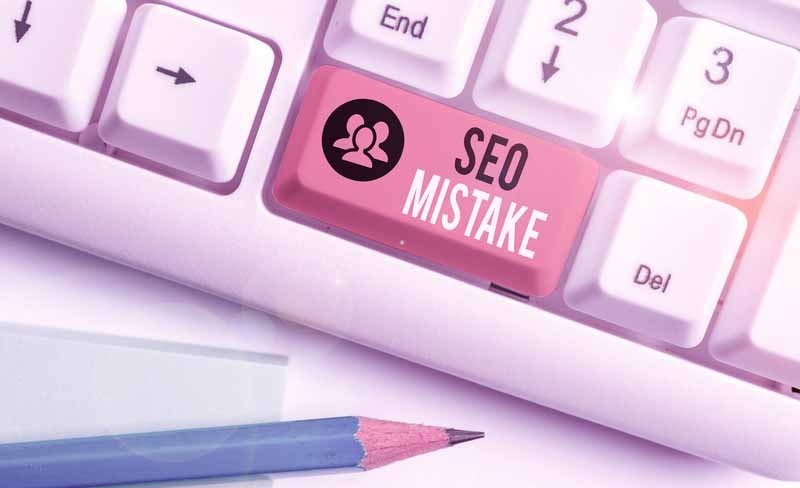Small businesses and corporations all yearn to rank on Google and appear first on the results page. But time after time, site owners perform the same SEO mistakes. In this article, we will run through common SEO mistakes along with tips on how to avoid them.
SEO demands more than including your main keyword ten times in a blog post. SEO covers everything from the user experience of the website to the internal links you include in your blog post. To help all the businesses out there, we’ll uncover the common SEO mistakes that prevent you from ranking on search engines. And more importantly, give you suggestions on how to avoid making these errors.
1. Not Considering the Mobile Experience
There’s no doubt that the average person spends hours on their phones, tablets and virtually any portable device. The wide usage of mobile devices motivates search engines like Google to prioritise mobile-first indexing.
Googlebots will analyse the quality of your site on both desktop and mobile platforms. As such, even with a top-notch desktop website, a poor quality mobile experience will badly affect your search engine rankings.
Businesses make this mistake all too often. They focus all their attention on the desktop experience and neglect how their site translates to mobile devices.
Tips
- Before you launch your website, check out how your website performs on all mobile devices.
- Click the buttons, try to make a purchase, look at the overall display – will users have a sound experience on your mobile website?
- You want to diagnose as many issues as you can before you launch your website.
2. Not following SEO guidelines
Everyone wants to rank on Google, Yahoo and Bing. So much so that some businesses will try to cut corners to achieve this. This includes buying backlinks.
Backlinks are when another website links directly to content on your site or vice versa. Some people decide to buy backlinks to increase their search engine ranking. But this goes against Google SEO policies. If Google catches you purchasing backlinks, Google will either flag your website or eliminate your chances of ranking on their search engine.
Tips
- Understand that SEO ranking takes time: getting recognised by the search engine can take weeks and months.
- Be patient: there are no sustainable shortcuts to ranking.
- Read through all of Google’s SEO policies and act by them.
- You will lose more than you will gain if you buy backlinks.
3. Not ranking for long-tail keywords
A common SEO mistake that many businesses make is choosing the wrong keywords. You might wonder, how can a keyword be ‘wrong?’ Are some keywords better than others? The short answer is yes.
Site owners often choose generic and popular keywords to rank for. For example, if a website sells flowers, the site owner may try to rank for ‘buy flowers’ and other generic terms. You want to avoid this at all costs.
With fierce competition against other established site owners, it becomes difficult and even impossible for you to rank for these keywords. For keyword selection, you want to do the opposite – choose unpopular keywords and rank for that. Even if those keywords receive far less traffic, you have a greater likelihood of ranking for them. And over time as your credibility builds, Google may rank your site for popular keywords as well.
Tips
- Use sites like Google trends or any keyword tools to see which keywords receive less traffic
- Aim for long-tail and specific keywords: the longer the keyword is, the more likely it receives less traffic
- Use these keywords on all pages of your website
4. Not caring about the user experience
Beyond the keywords, beyond the graphics, a mistake site owners make is neglecting the user experience of a website. If your website speed is slow, images do not appear, or the website is difficult to navigate, Google will not rank your website. Your website could be slow for multiple reasons:
- Unoptimised images: high-resolution images takes a long time to load
- Code issues: audit your code to make sure your class runs smoothly
Ensure your website runs smoothly before launching your site!
Tips
- Use images that are do not have a big file
- Optimise your code and remove any coding that does not serve a purpose for your site.
5. Not internal linking
You want people to keep their eyes on your site. This will not only increase your SEO ranking but will also encourage more readers to engage with your website content. One way to go about this is to use internal linking.
Linking to other parts of your site will prompt readers or customers to browse your site more. Search engines will keep tabs on the number of times visitors click on a link. Besides internal linking, you can also include call-to-action features. These call-to-action features will prompt people to engage with various parts of your site!
Tips
- Create blog posts that link to another part of your website for visitors.
- Add a ‘sign-up button, ‘buy’ button and other features that will keep visitors on your site for longer.
6. Not prioritising incredible content
People underestimate the power of strong and quality writing content. From blogs to the web copy on your site, it’s not all about the technicalities of SEO. If you provide value through stellar writing and content, this will help you soar to the top of the ranks on search engines. And many site owners struggle with this.
Whether it’s hiring a low-budget copywriter or rushing through the writing, the content itself is what visitors look for. You need to write for your readers, not for Google.
As more people visit your website due to your great writing, Google will reward you for that! Googlebots will scour through your website and ensure to put quality content above all else. Make sure you’re a part of that list.
Tips
- Don’t always focus on the length of a blog or web copy: focus on the quality of writing above all else
- Break down information in a digestible and easy way for readers: include lists, bullet points, shorter sentences, etc
- Hire a copywriter with good writing skills can bring life to words on a page.
7. Not focusing on metadata and titles
Metadata appears when someone searches up a question or looking to find something. Google initially reads your title and metadata and displays these as the results. Site owners don’t look into this enough.
Searchers lookout for titles and meta descriptions that suits exactly what they’re looking for. As such, have an attractive and unique title with a meta description to follow.
Tips
- Include your keyword into the title
- Make it an appealing title that will get readers interested in what you have to say
You can easily avoid these SEO mistakes. If you’re yearning to rank on top with search engines, it’s imperative to avoid the mistakes we’ve listed above. And hopefully, once you implement the tips we’ve suggested, you’ll find your site on the front pages!






